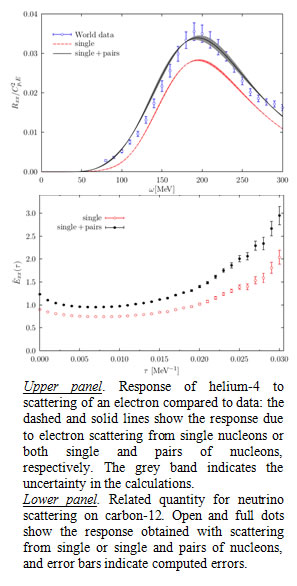 Microscopic calculations for neutrino scattering from nuclei
Microscopic calculations for neutrino scattering from nuclei
Although neutrinos were postulated in 1930 and first observed in 1956, the fact that they are not massless was only demonstrated in the 1990's the values of their masses is still unknown. We also do not know why our universe consists of almost pure matter with very little antimatter, contrary to predictions of the standard model of particle physics. Experimental neutrino physics is entering a new age of high-precision measurements that aim to address both these issues. The culmination of this effort will be the DUNE experiment; its liquid-argon detector in South Dakota will measure the neutrino beam generated 800 miles away at Fermilab. Current experiments depend on interactions with carbon nuclei. Precise theoretical knowledge of the interactions of neutrinos with nuclei is essential to interpreting the results of these experiments.
At Argonne, using one of the world's fastest computers, ab initio calculations of electron and neutrino interactions with helium-4 and carbon-12 have been carried out for the first time [1]. They are based on realistic interactions and the electron or neutrino is allowed to scatter directly from either single or pairs of nucleons. The theoretical results for the electron case agree well with experiment and demonstrate that direct interactions with nucleon pairs generate large additions to the interactions on just single nucleons. The neutrino results have similarly large two-body effects which now must be taken into account when analyzing neutrino experiments; an important point which was not previously appreciated.
Reference
- A. Lovato, S. Gandolfi, J. Carlson, S. Pieper and R. Schiavilla, Phys. Rev. C 91 (2015) 062501(R)
![[Argonne Logo]](/images/argonne_header_logo.jpg)
![[DOE Logo]](/images/header_doe.gif)